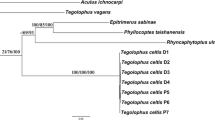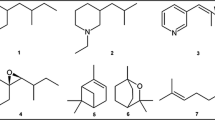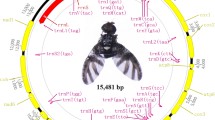Abstract
Males of the oriental fruit fly, Bactrocera dorsalis (Hendel) and some of its sibling species have strong affinity for methyl eugenol (ME). Methyl eugenol ingested by male flies is biotransformed in the crop to two ME metabolites that eventually accumulate in the rectal gland, which is known to serve as a reservoir for B. dorsalis sex pheromones. When fed with ME, males of laboratory and wild B. philippinensis Drew and Hancock selectively accumulated two metabolites, 2-allyl-4,5-dimethoxyphenol and (E)-coniferyl alcohol, in the rectal gland, as was seen for B. dorsalis sensu stricto, B. invadens Drew, Tsuruta and White, and B. papayae Drew and Hancock. Phylogenetic analysis of COI and rDNA sequence data of these four taxa also revealed a close relationship among B. philippinensis, B. dorsalis s.s., B. invadens, and B. papayae (all four are members of the dorsalis species complex). This result corroborates pheromone analysis. The usefulness of pheromonal analysis as a chemotaxonomy tool to complement molecular and other analysis in differentiation of closely related sibling species within the Bactrocera dorsalis complex, for which use of morphological characters had been inadequate, is highlighted.




Similar content being viewed by others

References
Armstrong KF, Cameron CM (2000) Species identification of tephritids across a broad taxonomic range using ribosomal DNA. In: Tan KH (ed) Area-wide Control of Fruit Flies and other Insect Pests. Penerbit USM, Penang, pp 203–710
Clarke AR, Armstrong KF, Carmichael AE, Milne JR, Raghu S, Roderick GK, Yeates DK (2005) Invasive phytophagous pests arising through a recent tropical evolutionary radiation: the Bactrocera dorsalis complex of fruit flies. Annu Rev Entomol 50:293–319
Drew RAI, Hancock DL (1994) The Bactrocera dorsalis complex of fruit flies (Diptera: Tephritidae: dacinae) in Asia. Bull Entomol Res Suppl 2:1–68
Giebultowicz JM, Webb RE, Raina AK, Ridgway RL (1992) Effects of temperature and age on daily changes in pheromone titer in laboratory reared and wild gypsy moth (Lepidoptera: Lymantriidae). Environ Entomol 21:822–826
Hee AKW, Tan KH (1998) Attraction of female and male Bactrocera papayae to conspecific males fed with methyl eugenol and attraction of females to male sex pheromone components. J Chem Ecol 24:753–764
Khoo CCH, Yuen KH, Tan KH (2000) Attraction of female Bactrocera papayae to sex pheromone components with two different release devices. J Chem Ecol 26:2487–2496
Krosch MN, Schutze MK, Armstrong KF, Graham GC, Yeates DK, Clarke AR (2012a) A molecular phylogeny for the Tribe Dacini (Diptera: Tephritidae): systematic and biogeographic implications. Mol Phylogenet Evol 64:513–523
Krosch MN, Schutze MK, Armstrong KF, Boontop Y, Boykin LM, Chapman TA, Englezou A, Cameron SL, Clarke AR (2012b) Piecing together an integrative taxonomic puzzle: microsatellite, wing shape and aedeagus length analyses of Bactrocera dorsalis s.l. (Diptera: Tephritidae) find no evidence of multiple lineages in a proposed contact zone along the Thai/Malay Peninsula. Syst Entomol 38:2–13
Löfstedt C, Herrebout WM, Menken SBJ (1991) Sex pheromones and their potential role in the evolution of reproductive isolation in small ermine moths (Yponomeutidae). Chemoecology 2:20–28
Mahmood K (1999) Intraspecific variations in two pest species of the Oriental fruit fly Bactrocera dorsalis (Hendel) (Tephritidae: Diptera) complex. Pak J Zool 31:315–321
Mahmood K (2004) Identification of pest species in Oriental fruit fly, Bactrocera dorsalis (Hendel) (Diptera: Tephritidae) species complex. Pak J Zool 36:219–230
Medina FIS, Carillo PAV, Gregorio JS, Aguilar CP (1998) The mating compatibility between Bactrocera philippinensis and Bactrocera dorsalis. In: Abstracts of 5th international symposium on fruit flies of economic importance, Penang, Malaysia, 1–5 June 1998 p 155
Muraji M, Nakahara S (2001) Phylogenetic relationships among fruit flies, Bactrocera (Diptera: Tephritidae), based on the mitochondrial rDNA sequences. Insect Mol Biol 10:549–559
Muraji M, Nakahara S, Ishida T, Minoura K, Miyazaki I, Kohama T (2008) The Philippines is a possible source of the Bactrocera dorsalis complex species (Diptera:Tephritidae) occasionally collected in the Ryukyu Islands of Japan; analyses of mitochondrial DNA. Appl Entomol Zool 43:609–615
Naeole CKM, Haymer DS (2003) Use of oligonucleotide arrays for molecular taxonomic studies of closely related species in the Oriental fruit fly (Bactrocera dorsalis) complex. Mol Ecol Notes 3:662–665
Nishida R, Fukami H (1990) Sequestration of distasteful compounds by some pharmacophagous insects. J Chem Ecol 16:151–164
Nishida R, Tan KH, Serit M, Lajis NH, Sukari AM, Takahashi S, Fukami H (1988) Accumulation of phenylpropanoids in the rectal glands of males of the Oriental fruit fly, Dacus dorsalis. Experientia 44:534–536
Nishida R, Shelly TE, Kaneshiro KY, Tan KH (2000) Roles of semiochemicals in mating systems: a comparison between oriental fruit fly and medfly. In: Tan KH (ed) Area-wide control of fruit flies and other insect pests. Penerbit USM, Penang, pp 631–637
Orankanok W, Chinvinijkul S, Sawatwangkhoung A, Pinkaew S, Orankanok S (2011) Methyl eugenol and pre-release diet improve mating performance of young Bactrocera dorsalis and Bactrocera correcta males. J Appl Entomol doi:10.1111/j.1439-0418.2011.01677.x
Raina AK, Stadelbacher EA, Ridgway RL (1989) Comparison of sex pheromone composition and pheromone-mediated male behavior of laboratory-reared and wild Heliothis zea (Lepidoptera: Noctuidae). J Chem Ecol 15:1259–1265
Schutze MK, Krosch MN, Armstrong KF, Chapman TA, Englezou A, Chomič A, Cameron SL, Hailstones D, Clarke AR (2012) Population structure of Bactrocera dorsalis s.s., B. papayae and B. philippinensis (Diptera: Tephritidae) in southeast Asia: evidence for a single species hypothesis using mitochondrial DNA and wing-shape data. BMC Evol Biol 12:130
Shelly TE (2000) Flower-feeding affects mating performance in male Oriental fruit flies Bactrocera dorsalis. Ecol Entomol 25:109–114
Shelly TE, Dewire AM (1994) Chemically mediated mating success in male Oriental fruit flies (Diptera: Tephritidae). Ann Entomol Soc Am 87:375–382
Shelly TE, Nishida R (2004) Larval and adult feeding on methyl eugenol and the mating success of male oriental fruit flies, Bactrocera dorsalis (Hendel) (Diptera: Tephritidae). Entomol Exp Appl 112:155–158
Shelly T, Resilva S, Reyes M, Bignayan H (1996) Methyl eugenol and mating competitiveness of irradiated male Bactrocera philippinensis (Diptera: Tephritidae). Fla Entomol 79:481–488
Tamura K, Peterson D, Peterson N, Stecher G, Nei M, Kumar S (2011) MEGA5: Molecular evolutionary genetics analysis using maximum likelihood, evolutionary distance, and maximum parsimony methods. Mol Biol Evol 28:2731–2739
Tan KH (2003) Interbreeding and DNA analysis of sibling species within the Bactrocera dorsalis complex. In: Recent trends on sterile insect technique and area-wide integrated pest management—economic feasibility, control projects, farmer organization and Bactrocera dorsalis complex control study. Research Institute for Subtropics, Okinawa, Japan, pp 113–122
Tan KH, Nishida R (1996) Sex pheromone and mating competition after methyl eugenol consumption in the Bactrocera dorsalis complex. In: McPheron BA, Steck GJ (eds) Fruit fly pests: a world assessment of their biology and management. St. Lucid Press, Florida, pp 147–153
Tan KH, Nishida R (1998) Ecological significance of male attractant in the defence and mating strategies of the fruit fly, Bactrocera papayae. Entomol Exp Appl 89:155–158
Tan KH, Nishida R (2012) Methyl eugenol: Its occurrence, distribution, and role in nature, especially in relation to insect behavior and pollination. J Insect Sci 12(56):1–74
Tan KH, Nishida R, Toong YC (2002) Floral synomone of a wild orchid, Bulbophyllum cheiri, lures Bactrocera fruit flies for pollination. J Chem Ecol 28:1161–1172
Tan KH, Tan LT, Nishida R (2006) Floral phenylpropanoid cocktail and architecture of Bulbophyllum vinaceum orchid in attracting fruit flies for pollination. J Chem Ecol 32:2429–2441
Tan KH, Tokushima I, Ono H, Nishida R (2011) Comparison of phenylpropanoid volatiles in male rectal pheromone gland after methyl eugenol consumption, and molecular phylogenetic relationship of four global pest fruit fly species: Bactrocera invadens, B. dorsalis, B. correcta and B. zonata. Chemoecology 21:25–33
Tokushima I, Orankanok W, Tan KH, Ono H, Nishida R (2010) Accumulation of phenylpropanoid and sesquiterpenoid volatiles in male rectal pheromonal glands of the guava fruit fly, Bactrocera correcta. J Chem Ecol 36:1327–1334
Wee SL, Tan KH (2001) Allomonal and hepatotoxic effects following methyl eugenol consumption in Bactrocera papayae male against Gekko monarchus. J Chem Ecol 27:953–964
Wee SL, Tan KH (2007) Temporal accumulation of phenylpropanoids in male fruit flies, Bactrocera dorsalis and B. carambolae (Diptera: Tephritidae) following methyl eugenol consumption. Chemoecology 17:81–85
Wee SL, Tan KH, Nishida R (2007) Pharmacophagy of methyl eugenol by males enhances sexual selection of Bactrocera carambolae. J Chem Ecol 33:1272–1282
Zhang B, Liu YH, Wu WX, Wang ZL (2010) Molecular phylogeny of Bactrocera species (Diptera: Tephritidae: Dacini) inferred from mitochondrial sequences of 16S rDNA and COI sequences. Fla Entomol 93:369–377
Acknowledgments
The authors would like to thank Andrew Jessup and Mark Schutze (FAO/IAEA Agriculture and Biotechnology Laboratory, Seibersdorf, Austria) for supplying sexually mature live male flies of B. philippinensis and specimens of B. invadens in alcohol, W. Orankanok and S. Chinvinijkul (Department of Agricultural Extension, Bangkok) for B. correcta and B. dorsalis, S. Permalloo (Entomology Division, Ministry of AgroIndustry and Fisheries, Mauritius) for B. zonata, and Hiroshi Enomoto for the wild B. philippinensis flies from Luzon island. Two of us (Tan and Wee) also express our sincere gratitude to Jorge Hendrichs of International Atomic Energy Agency, Vienna, for sponsoring our trip to Vienna during which feeding and extraction experiments were conducted. This work was partly supported by International Atomic Energy Agency-Coordinated Research Projects Contract numbers 16066 and 16160, and the Grant-in-Aid for Scientific Research from JSPS (No. 23380035) from the Ministry of Education, Culture, Sports, Science and Technology of Japan, and JST in Research for Promoting Technological Seeds (under R. Nishida).
Author information
Authors and Affiliations
Corresponding author
Rights and permissions
About this article
Cite this article
Tan, K.H., Wee, SL., Ono, H. et al. Comparison of methyl eugenol metabolites, mitochondrial COI, and rDNA sequences of Bactrocera philippinensis (Diptera: Tephritidae) with those of three other major pest species within the dorsalis complex. Appl Entomol Zool 48, 275–282 (2013). https://doi.org/10.1007/s13355-013-0183-5
Received:
Accepted:
Published:
Issue Date:
DOI: https://doi.org/10.1007/s13355-013-0183-5



